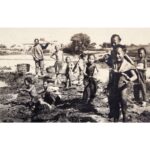Photography Manchu Women in Winter Clothing
A black-and-white photograph, studio portrait of an upper-class Manchu woman standing at a table with a tea cup. Behind it is an opium pipe. On the floor in front of the table is a potted chrysanthemum. The Manchu woman is dressed in a long one-piece silk robe. Over this she wears a silk vest majia 馬甲 with a distinctive protective collar, huling 護領. In the late Qing Dynasty, this gradually covered the entire neck. This combination was often the informal dress of Manchu women. The vest is in the shape of a pipajin majia 琵琶襟馬甲; it is one of the four typical shapes with front fastening. Characteristically, the side of the front fold is cut asymmetrically, with a slight incision at the neck and a deeper square cut at the waist. Vests were worn on various occasions. The everyday vest, for example, was simpler, more modestly decorated, and made of less prestigious materials. The clothes are lined to provide more comfort on cold winter days.
The edges of the garments ... more
A black-and-white photograph, studio portrait of an upper-class Manchu woman standing at a table with a tea cup. Behind it is an opium pipe. On the floor in front of the table is a potted chrysanthemum. The Manchu woman is dressed in a long one-piece silk robe. Over this she wears a silk vest majia 馬甲 with a distinctive protective collar, huling 護領. In the late Qing Dynasty, this gradually covered the entire neck. This combination was often the informal dress of Manchu women. The vest is in the shape of a pipajin majia 琵琶襟馬甲; it is one of the four typical shapes with front fastening. Characteristically, the side of the front fold is cut asymmetrically, with a slight incision at the neck and a deeper square cut at the waist. Vests were worn on various occasions. The everyday vest, for example, was simpler, more modestly decorated, and made of less prestigious materials. The clothes are lined to provide more comfort on cold winter days.
The edges of the garments are decorated with finely embroidered floral patterns. They are also found on the typical erbatou 二把頭 hairstyle by which we recognise Manchu women. The hairstyle consists of two figs attached to each side of the head and reinforced with an additional wire frame and extensions. It is adorned with various decorations – from flowers to jewellery. A Manchu woman wears metal jewellery on her fingers. The thimble on her left hand and its long pointed-nail shape are clearly visible in the photo. With this shape, which prevented any practical use of the fingers, the women showed that they did not have to do any (manual) work. The Manchu woman wears lipstick. This form of lip makeup, emphasising the entire upper lip and the middle part of the lower lip, was one of two fashionable options for women in the Qing Dynasty.
Chrysanthemums (juhua 菊花), a common motif in Chinese tradition, are planted in a pot on the ground. The symbolic meaning of the chrysanthemum, sincerity and perseverance, comes from the fact that it blooms on cold winter days and heralds winter. The photographs were taken in the same studio as the photography “Chinese and Manchu”. Both show the same woman, faucet and chrysanthemums, which can be seen in other photo collections.
The photograph is the 156th of 449 photographs of Beijing and its surroundings in the album of Ivan Skušek Jr., purchased during his stay in Beijing (1914–1920). In the handwritten inventory of the album, the photograph is referred to as Mandschufrau im Winterkleid. (DZ, MV)





































Do you have a comment or additional information about the subject?